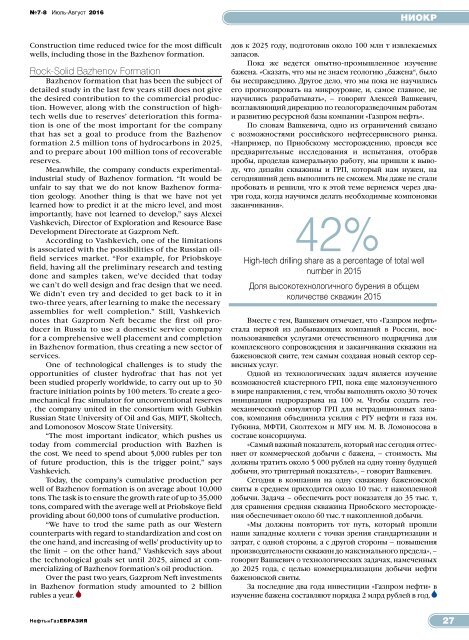Oil&Gas Eurasia July-August 2016
July-August issue of Oil&Gas Eurasia magazine
July-August issue of Oil&Gas Eurasia magazine
You also want an ePaper? Increase the reach of your titles
YUMPU automatically turns print PDFs into web optimized ePapers that Google loves.
№7-8 Июль-Август <strong>2016</strong><br />
НИОКР<br />
Construction time reduced twice for the most difficult<br />
wells, including those in the Bazhenov formation.<br />
Rock-Solid Bazhenov Formation<br />
Bazhenov formation that has been the subject of<br />
detailed study in the last few years still does not give<br />
the desired contribution to the commercial production.<br />
However, along with the construction of hightech<br />
wells due to reserves’ deterioration this formation<br />
is one of the most important for the company<br />
that has set a goal to produce from the Bazhenov<br />
formation 2.5 million tons of hydrocarbons in 2025,<br />
and to prepare about 100 million tons of recoverable<br />
reserves.<br />
Meanwhile, the company conducts experimentalindustrial<br />
study of Bazhenov formation. “It would be<br />
unfair to say that we do not know Bazhenov formation<br />
geology. Another thing is that we have not yet<br />
learned how to predict it at the micro level, and most<br />
importantly, have not learned to develop,” says Alexei<br />
Vashkevich, Director of Exploration and Resource Base<br />
Development Directorate at Gazprom Neft.<br />
According to Vashkevich, one of the limitations<br />
is associated with the possibilities of the Russian oilfield<br />
services market. “For example, for Priobskoye<br />
field, having all the preliminary research and testing<br />
done and samples taken, we’ve decided that today<br />
we can’t do well design and frac design that we need.<br />
We didn’t even try and decided to get back to it in<br />
two-three years, after learning to make the necessary<br />
assemblies for well completion.” Still, Vashkevich<br />
notes that Gazprom Neft became the first oil producer<br />
in Russia to use a domestic service company<br />
for a comprehensive well placement and completion<br />
in Bazhenov formation, thus creating a new sector of<br />
services.<br />
One of technological challenges is to study the<br />
opportunities of cluster hydrofrac that has not yet<br />
been studied properly worldwide, to carry out up to 30<br />
fracture initiation points by 100 meters. To create a geomechanical<br />
frac simulator for unconventional reserves<br />
, the company united in the consortium with Gubkin<br />
Russian State University of Oil and <strong>Gas</strong>, MIPT, Skoltech,<br />
and Lomonosov Moscow State University.<br />
“The most important indicator¸ which pushes us<br />
today from commercial production with Bazhen is<br />
the cost. We need to spend about 5,000 rubles per ton<br />
of future production, this is the trigger point,” says<br />
Vashkevich.<br />
Today, the company’s cumulative production per<br />
well of Bazhenov formation is on average about 10,000<br />
tons. The task is to ensure the growth rate of up to 35,000<br />
tons, compared with the average well at Priobskoye field<br />
providing about 60,000 tons of cumulative production.<br />
“We have to trod the same path as our Western<br />
counterparts with regard to standardization and cost on<br />
the one hand, and increasing of wells’ productivity up to<br />
the limit – on the other hand,” Vashkevich says about<br />
the technological goals set until 2025, aimed at commercializing<br />
of Bazhenov formation’s oil production.<br />
Over the past two years, Gazprom Neft investments<br />
in Bazhenov formation study amounted to 2 billion<br />
rubles a year.<br />
дов к 2025 году, подготовив около 100 млн т извлекаемых<br />
запасов.<br />
Пока же ведется опытно-промышленное изучение<br />
бажена. «Сказать, что мы не знаем геологию „бажена“, было<br />
бы несправедливо. Другое дело, что мы пока не научились<br />
его прогнозировать на микроуровне, и, самое главное, не<br />
научились разрабатывать», – говорит Алексей Вашкевич,<br />
возглавляющий дирекцию по геологоразведочным работам<br />
и развитию ресурсной базы компании «Газпром нефть».<br />
По словам Вашкевича, одно из ограничений связано<br />
с возможностями российского нефтесервисного рынка.<br />
«Например, по Приобскому месторождению, проведя все<br />
предварительные исследования и испытания, отобрав<br />
пробы, проделав камеральную работу, мы пришли к выводу,<br />
что дизайн скважины и ГРП, который нам нужен, на<br />
сегодняшний день выполнить не сможем. Мы даже не стали<br />
пробовать и решили, что к этой теме вернемся через дватри<br />
года, когда научимся делать необходимые компоновки<br />
заканчивания».<br />
42%<br />
High-tech drilling share as a percentage of total well<br />
number in 2015<br />
Доля высокотехнологичного бурения в общем<br />
количестве скважин 2015<br />
Вместе с тем, Вашкевич отмечает, что «Газпром нефть»<br />
стала первой из добывающих компаний в России, воспользовавшейся<br />
услугами отечественного подрядчика для<br />
комплексного сопровождения и заканчивания скважин на<br />
баженовской свите, тем самым создавая новый сектор сервисных<br />
услуг.<br />
Одной из технологических задач является изучение<br />
возможностей кластерного ГРП, пока еще малоизученного<br />
в мире направления, с тем, чтобы выполнять около 30 точек<br />
инициации гидроразрыва на 100 м. Чтобы создать геомеханический<br />
симулятор ГРП для нетрадиционных запасов,<br />
компания объединила усилия с РГУ нефти и газа им.<br />
Губкина, МФТИ, Сколтехом и МГУ им. М. В. Ломоносова в<br />
составе консорциума.<br />
«Самый важный показатель¸ который нас сегодня оттесняет<br />
от коммерческой добычи с бажена, – стоимость. Мы<br />
должны тратить около 5 000 рублей на одну тонну будущей<br />
добычи, это триггерный показатель», – говорит Вашкевич.<br />
Сегодня в компании на одну скважину баженовской<br />
свиты в среднем приходится около 10 тыс. т накопленной<br />
добычи. Задача – обеспечить рост показателя до 35 тыс. т,<br />
для сравнения средняя скважина Приобского месторождения<br />
обеспечивает около 60 тыс. т накопленной добычи.<br />
«Мы должны повторить тот путь, который прошли<br />
наши западные коллеги с точки зрения стандартизации и<br />
затрат, с одной стороны, а с другой стороны – повышения<br />
производительности скважин до максимального предела», –<br />
говорит Вашкевич о технологических задачах, намеченных<br />
до 2025 года, с целью коммерциализации добычи нефти<br />
баженовской свиты.<br />
За последние два года инвестиции «Газпром нефти» в<br />
изучение бажена составляют порядка 2 млрд рублей в год.<br />
Нефтьи ГазЕВРАЗИЯ<br />
27











